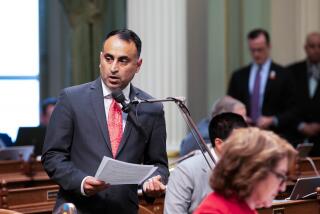Column: Do we need Obamacare’s ‘Cadillac tax’? Yes--and no.
- Share via
Despite the success of the Affordable Care Act’s supporters in fending off a raft of challenges to the law in Congress and the courts, at least one ACA provision seems headed for the scrap heap.
That’s the “Cadillac tax,” a stiff tax that will hit especially generous employer health plans starting in 2018. Almost everyone who’s anyone detests the tax: Republicans are dead set against it; Hillary Clinton has spoken out against it; corporate leaders hate it but so do unions, which have negotiated good benefits for their members or sponsor generous multiemployer health plans that might well trigger the hit.
The only love the Cadillac tax gets tends to come from economists, 101 of whom signed a letter published in October defending the tax. Among their arguments were that the tax restores fairness to a system that exempts from taxation the premiums paid by workers and employers on employer plans, but not the premiums paid by individuals on their plans; that prompting employers to reduce insurance benefits will give consumers more “incentive to insist on cost-effective care”; and that the tax will bring in an estimated $91 billion over the next decade that would have to be made up in some other way.
When a consumer is insulated from the costs of health care by a Cadillac insurance plan, then their tendency is to overuse services.
— Ritu Agarwal, University of Maryland
Given this imbalance of cons over pros, it’s hardly surprising that repeal or delay of the Cadillac tax is on the table right now in the current congressional negotiations over a government funding package. Even if the issue is set aside, it’s likely to remain live right up to the enactment point in 2018.
Because it’s not as central a tenet of Obamacare as, say, the individual mandate or the tax subsidies for lower-income insurance customers--which have been the focus of political and court challenges to the law thus far--it’s conceivable that President Obama himself might accede to a delay or repeal. That’s especially so because some of the goals of the Cadillac tax could be achieved in different ways--or are already happening. Let’s take a look.
Here are the basics: Starting in 2018, the “high cost plan tax” amounts to 40% of the value of employer plans over the threshold of $10,200 for single coverage and $27,500 for family plans. The figures are adjusted for inflation after that. The Kaiser Family Foundation estimates that 26% of employers would owe at least some Cadillac tax in 2018, and 42% by 2028.
That’s why the received wisdom is that the tax will cause employers to ratchet back benefits to bring their health plans’ values below the tax threshold. That’s only a theory at this point, since the tax is still two years off.
But the empirical evidence we do possess about employer behavior suggests that they don’t really need the Cadillac tax to justify cutting healthcare benefits. The reduction in costs is more than enough incentive. As the Kaiser Family Foundation has documented, employers have been reducing benefits and increasing workers’ costs consistently for years--and the trends dates back to well before the enactment of the Affordable Care Act.
The percentage of workers enrolled in an employer plan with an annual deductible of $1,000 or more for single coverage has risen from 10% to 46% over the last decade, KFF found. Though premiums for family coverage have increased 61% in that period (from an average $10,880 to $17,545), the worker share of those premium has increased 83%.
Employees contributed an average of less than 25% to their healthcare premiums in 2005; today the average is more than 28%. That higher share of higher premiums doesn’t even count the higher deductibles and co-pays they’re facing every year.
What may have changed with the Cadillac tax is that employers now have a scapegoat to make changes they’d do anyway. One clue to this effect is that some employers started blaming Obamacare in general and the Cadillac tax specifically for cutbacks in health benefits as early as 2013, five years before the tax is to begin. As 2018 draws nearer, more employers are talking about how they have to start cutting benefits now, so workers don’t get a “shock” from their being cut abruptly in 2018.
This is a fairly cynical argument. How many of your co-workers would prefer losing benefits today to ease the pain instead of keeping them for the next two years and dealing with the cutbacks later?
The idea that consumers are more discerning about healthcare when they have “skin in the game,” that is, via higher deductibles and co-pays, is a slippery one.
“When a consumer is insulated from the costs of healthcare by a Cadillac insurance plan, then their tendency is to overuse services,” says Ritu Agarwal of the University of Maryland. But studies have pointed to a complicated effect: Faced with sizable costs, consumers will cut back on unnecessary care, but also on necessary care. Patients with higher out-of-pocket obligations tend to be worse at taking their prescriptions and can end up with worse health as a result. The point at which this happens is nebulous, as is evident from the fact that it’s still the topic of vigorous professional discussion.
It’s probably true that U.S. healthcare consumers in general are more sensitive to the price of certain procedures and more willing to reduce their own costs by becoming more discerning about the treatments they seek and where. There’s growing evidence that hospitals are becoming more efficient, in response to pressure from patients as well as big healthcare buyers such as insurers and Medicare.
Deductibles and higher premiums, which will be affected by the Cadillac tax, are blunt instruments to achieve these ends, but certainly not the only ones. What’s missing, moreover, is better information about the cost of treatments. Consumers can’t price-shop if they can’t determine the price, which is is only rarely possible.
What about equalizing the tax exemption of premiums? The ACA’s tax subsidies for middle- and low-income insurance buyers helped to redress the imbalance, but only a tiny bit. Tax subsidies for employer premiums cost the government an estimated $250 billion a year, swamping the value of the tax subsidies allocated to individual insurance buyers under the Affordable Care Act (about $45 billion in 2014).
As for replacing the revenue lost by repeal or delay of the tax, surely that’s well within the expertise of Congress. Like several other revenue-producing provisions of the ACA, one chief driver of the tax provision was conservatives’ insistence that every piece of the law be paid for with new revenues. The result was a patchwork of levies affecting medical devices, insurance carriers, even tanning salons. Lawmakers who decide they don’t want to saddle employers with this tax are free to find somewhere, or someone, else to bite.
It may be time to pronounce the Cadillac tax moribund, but it’s certainly inaccurate to treat it as a nail in Obamacare’s coffin. Instead of fighting the change, the ACA’s supporters need to shift to taking its demise as a fact of life, and figuring out how to proceed without it. The options are plentiful.
Keep up to date with Michael Hiltzik. Follow @hiltzikm on Twitter, see our Facebook page, or email michael.hiltzik@latimes.com.
MORE FROM MICHAEL HILTZIK
What George F. Will gets wrong about the progressive income tax
One-sixth of Americans have trouble paying medical bills. That’s good news.
Forget the Zack Greinke deal. Major league ballplayers are getting ripped off.
More to Read
Inside the business of entertainment
The Wide Shot brings you news, analysis and insights on everything from streaming wars to production — and what it all means for the future.
You may occasionally receive promotional content from the Los Angeles Times.










